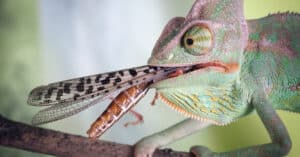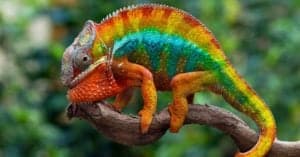Chameleons are incredible reptiles that are known for their ability to change color. There are over 200 species in the chameleon family, Chamaeleonidae. However, only a handful of these species are generally kept as pets. Veiled chameleons (Chamaeleo calyptratus) are the species that are most commonly kept as pets. In fact, they have been kept as pets for over 30 years. Other pet chameleon species can be less tolerant of captivity and harder to keep healthy.
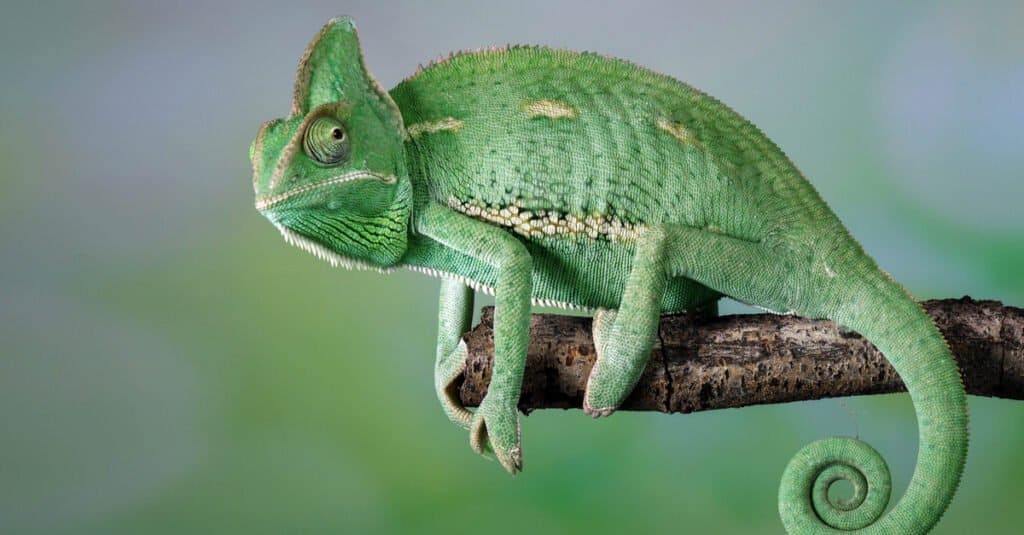
Veiled chameleons are good pets because they are more tolerant of captivity and easiest to keep healthy.
©Lauren Suryanata/Shutterstock.com
Many chameleons are protected species, so you need a permit to own one as a pet. A permit must be obtained through the Convention on International Trade in Endangered Species (CITES) program. Under the CITES program, it is legal to trade chameleons but illegal to take them from the wild. Veiled chameleons are one of many chameleon species protected by CITES. If you are looking to buy a pet chameleon, it is important to know that you are getting the animal from a legal and responsible seller. This article covers the cost of a pet chameleon in 2024.
A pet chameleon is a big responsibility. In order to keep a pet chameleon healthy, you need the proper care and supplies. This article covers all of the chameleon pet costs, including the animal itself, cage, food, supplies, and pet insurance.
How Much Does a Chameleon Cost?
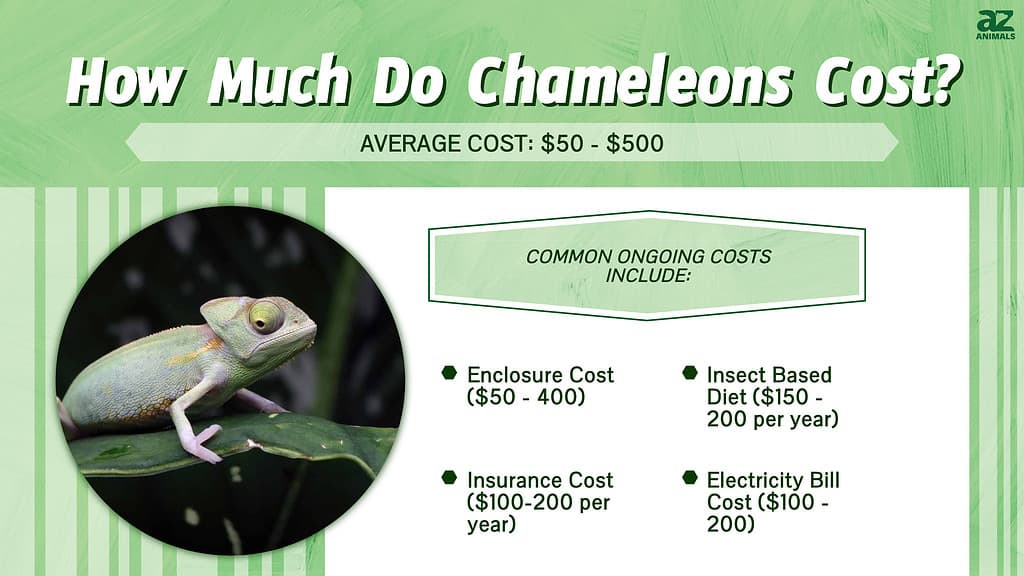
A pet chameleon can be a big investment. The cost of a chameleon is not only the cost of the animal itself but also the cost of its cage, food, supplies, and pet insurance or veterinary care. This article breaks down all of these costs.
Chameleon Cost
$50-500
The cost of a pet chameleon can range from low to high, depending on many factors. The first factor is species. This article focuses on veiled chameleons because they are the most common chameleon pet species.
Another factor that affects chameleon cost is where you buy. The options are pet stores, breeders, or private owners. Regardless of where you buy, always ask the seller for CITES paperwork on the animal. Since veiled chameleons are a protected species, you want to be sure you are buying and owning one legally.
Finally, the last determining factors of cost are age and sex. Generally, adults cost more than baby or juvenile chameleons. Additionally, males cost more than females because they tend to have brighter colors and longer lifespans.
A pet veiled chameleon generally costs between $50-200. The lower end of this range generally represents smaller and younger animals and those with normal coloring. For chameleons with special coloring, the price can be up to $500. An example of unique coloring can be found in translucent veiled chameleons.

Baby chameleons and female chameleons are the cheapest pet options.
©Kurit afshen/Shutterstock.com
Enclosure Cost
$50-400
The enclosure and supplies are big upfront costs. However, it is possible to save money by buying secondhand, if available. The cost of a tank mostly depends on its size. A chameleon needs a tank that is at least 18x30x30. For larger chameleons, a larger tank is required.
In addition to the tank itself, many additional supplies are necessary for keeping a chameleon healthy. The next section covers all of these supplies and their cost.
Supplies Cost
$320-580
Chameleons typically live in environments that are very different from human homes. There are a lot of necessary supplies to keep a pet chameleon healthy and happy. These supplies need to replicate a chameleon’s natural environment.
First, chameleons need lighting. For chameleons to properly process calcium, they need a UVB light. They also need a heating lamp to regulate their body temperature. Additionally, a thermometer is necessary for making sure the tank is at the right temperature. Another important supply is a misting system to maintain the tank’s humidity. A plant dripper is also necessary to supply water to your pet. Pet chameleons also need plants in their enclosure to climb on and hide in. Finally, a live food enclosure is necessary to house a chameleon’s live food.
The table below breaks down the initial cost of chameleon supplies.
| Supply | Cost |
|---|---|
| Lighting | $100-150 |
| Thermometer | $10-30 |
| Misting System | $50-150 |
| Plant Dripper | $50 |
| Plants | $100-200 |
| Live food enclosure | $10-30 |
| Total | $320-580 |
Food and Supplements Cost
$150-200 per year
Chameleons have an insect-based diet but can also eat plant foods. The most common food for pet chameleons is live crickets. A 10-day supply of crickets is around $5. A full year’s supply is $100-150. Chameleons also need calcium and vitamin A supplements. These supplements cost around $50 a year.
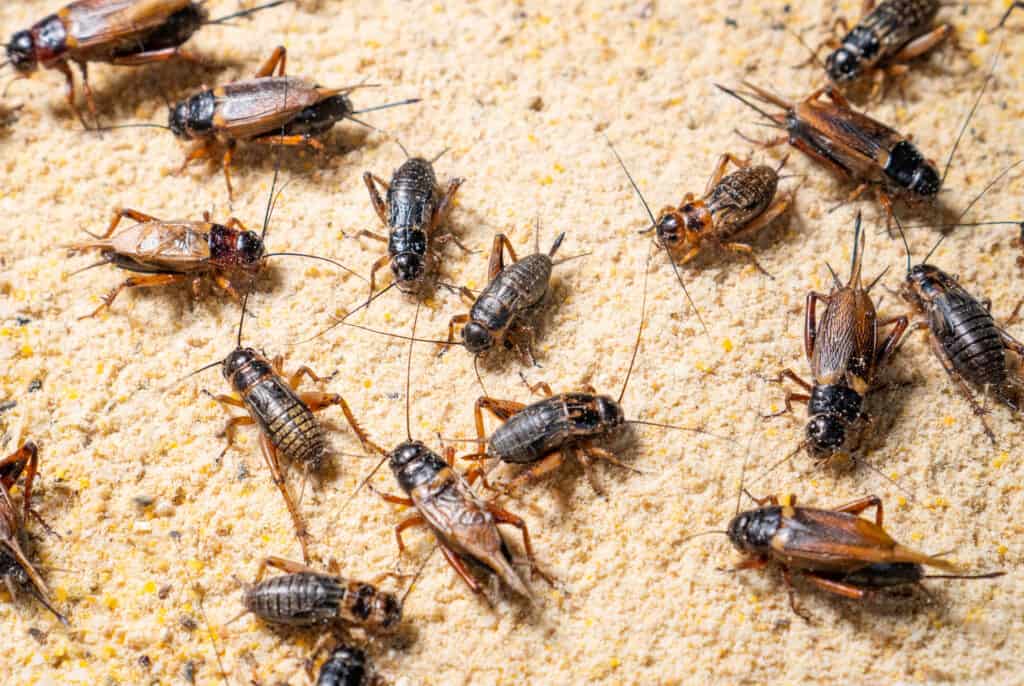
A pet chameleon’s diet is mainly live crickets. Chameleon owners need an enclosure for this live food.
©iStock.com/amnat jomjun
Insurance Cost
$100-200 per year
Pet insurance is a great way to afford veterinary costs. Since chameleons are unique pets, the cost of vet care can be quite high. The most cost-effective way to make sure a pet chameleon has the care they need is pet insurance. Pet insurance for a chameleon costs an average of $10 a month. Generally, a chameleon owner can expect to pay $100-200 a year for pet insurance.
Electricity Bill Cost
$100-200 per year
In addition to the animal, tank, and all the required supplies, an ongoing cost of maintaining a pet chameleon is electricity. Chameleon tanks demand a lot of energy for lighting and misting. Chameleon pet owners can expect a yearly energy bill increase of $100-200.
Total Initial Chameleon Cost
$485-1,690
The total initial cost of a pet chameleon is between $485-1,690. These costs are for the chameleon itself, the tank, supplies, and food. The proper supplies are crucial to a healthy pet chameleon. The lower end of this cost spectrum is for younger and female chameleons and cheaper supplies. The higher end of the spectrum is for older and male chameleons, as well as chameleons with unique colors. As for supplies, the tank size is a large factor of the initial expense of a chameleon. A smaller tank makes the cost lower, but it is important to make sure the tank is large enough to house the animal comfortably.
| Animal/Item | Cost |
|---|---|
| Chameleon | $50-500 |
| Tank | $50-400 |
| Supplies | $320-580 |
| Food and Supplements | $55-200 (two weeks to a year food supply) |
| Pet Insurance (One Month) | $10 |
| Total | $485-1,690 |
Total Ongoing Chameleon Cost
In addition to initial expenses, pet chameleons also have ongoing expenses. A pet chameleon needs ongoing food, supplements, and supplies. Some supplies that you buy initially will need to be replaced over time. One thing you can expect to replace regularly is lamp bulbs. Like the lightbulbs in our homes, the bulbs in chameleon tanks go out and need replacements. It is also a good idea to have pet insurance to avoid expensive vet bills. Pet insurance is another ongoing cost of a pet chameleon.
$450-750
| Item | Cost (Per Year) |
|---|---|
| Food and Supplements | $150-200 |
| Pet Insurance | $100-200 |
| Replacement Lighting and Plants | $100-150 |
| Energy Bill Cost | $100-200 |
| Total | $450-750 |
Conclusion
The cost of a pet chameleon can vary greatly depending on a number of factors. A person can expect the initial cost of a pet chameleon in 2024 to be $485-1,690. Additionally, ongoing costs are $450-750 per year.
The photo featured at the top of this post is © Lauren Suryanata/Shutterstock.com
Thank you for reading! Have some feedback for us? Contact the AZ Animals editorial team.



